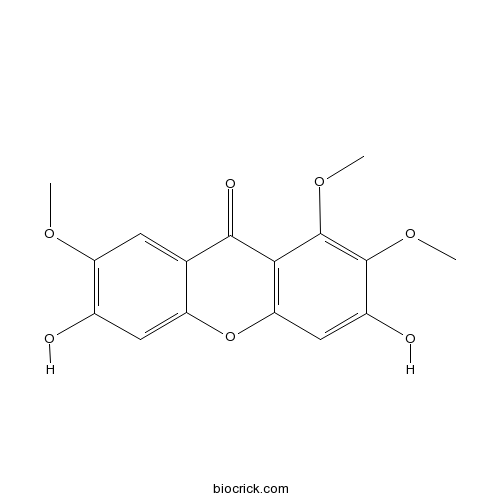3,6-Dihydroxy-1,2,7-trimethoxyxanthoneCAS# 916210-79-2 |

Quality Control & MSDS
3D structure
Package In Stock
Number of papers citing our products

| Cas No. | 916210-79-2 | SDF | Download SDF |
| PubChem ID | 56928514 | Appearance | Powder |
| Formula | C16H14O7 | M.Wt | 318.28 |
| Type of Compound | Xanthones | Storage | Desiccate at -20°C |
| Solubility | Soluble in Chloroform,Dichloromethane,Ethyl Acetate,DMSO,Acetone,etc. | ||
| Chemical Name | 3,6-dihydroxy-1,2,7-trimethoxyxanthen-9-one | ||
| SMILES | COC1=C(C=C2C(=C1)C(=O)C3=C(O2)C=C(C(=C3OC)OC)O)O | ||
| Standard InChIKey | CAFZLSJOANEDGR-UHFFFAOYSA-N | ||
| Standard InChI | InChI=1S/C16H14O7/c1-20-11-4-7-10(5-8(11)17)23-12-6-9(18)15(21-2)16(22-3)13(12)14(7)19/h4-6,17-18H,1-3H3 | ||
| General tips | For obtaining a higher solubility , please warm the tube at 37 ℃ and shake it in the ultrasonic bath for a while.Stock solution can be stored below -20℃ for several months. We recommend that you prepare and use the solution on the same day. However, if the test schedule requires, the stock solutions can be prepared in advance, and the stock solution must be sealed and stored below -20℃. In general, the stock solution can be kept for several months. Before use, we recommend that you leave the vial at room temperature for at least an hour before opening it. |
||
| About Packaging | 1. The packaging of the product may be reversed during transportation, cause the high purity compounds to adhere to the neck or cap of the vial.Take the vail out of its packaging and shake gently until the compounds fall to the bottom of the vial. 2. For liquid products, please centrifuge at 500xg to gather the liquid to the bottom of the vial. 3. Try to avoid loss or contamination during the experiment. |
||
| Shipping Condition | Packaging according to customer requirements(5mg, 10mg, 20mg and more). Ship via FedEx, DHL, UPS, EMS or other couriers with RT, or blue ice upon request. | ||

3,6-Dihydroxy-1,2,7-trimethoxyxanthone Dilution Calculator

3,6-Dihydroxy-1,2,7-trimethoxyxanthone Molarity Calculator
| 1 mg | 5 mg | 10 mg | 20 mg | 25 mg | |
| 1 mM | 3.1419 mL | 15.7094 mL | 31.4189 mL | 62.8378 mL | 78.5472 mL |
| 5 mM | 0.6284 mL | 3.1419 mL | 6.2838 mL | 12.5676 mL | 15.7094 mL |
| 10 mM | 0.3142 mL | 1.5709 mL | 3.1419 mL | 6.2838 mL | 7.8547 mL |
| 50 mM | 0.0628 mL | 0.3142 mL | 0.6284 mL | 1.2568 mL | 1.5709 mL |
| 100 mM | 0.0314 mL | 0.1571 mL | 0.3142 mL | 0.6284 mL | 0.7855 mL |
| * Note: If you are in the process of experiment, it's necessary to make the dilution ratios of the samples. The dilution data above is only for reference. Normally, it's can get a better solubility within lower of Concentrations. | |||||

Calcutta University

University of Minnesota

University of Maryland School of Medicine

University of Illinois at Chicago

The Ohio State University

University of Zurich

Harvard University

Colorado State University

Auburn University

Yale University

Worcester Polytechnic Institute

Washington State University

Stanford University

University of Leipzig

Universidade da Beira Interior

The Institute of Cancer Research

Heidelberg University

University of Amsterdam

University of Auckland

TsingHua University

The University of Michigan

Miami University

DRURY University

Jilin University

Fudan University

Wuhan University

Sun Yat-sen University

Universite de Paris

Deemed University

Auckland University

The University of Tokyo

Korea University
- 5-Methoxyseselin
Catalog No.:BCN9451
CAS No.:31525-76-5
- Seselin
Catalog No.:BCN9450
CAS No.:523-59-1
- 12-O-Methylinophyllum A
Catalog No.:BCN9449
CAS No.:2131757-10-1
- (-)-Toddalolactone 3′-O-β-D-glucopyranoside
Catalog No.:BCN9448
CAS No.:1176645-57-0
- ent-15α-Acetoxy-11α-hydroxykaur-16-en-19-oic acid
Catalog No.:BCN9447
CAS No.:70324-38-8
- Uncarine F
Catalog No.:BCN9446
CAS No.:14019-66-0
- Angustine
Catalog No.:BCN9445
CAS No.:40041-96-1
- Caloxanthone B
Catalog No.:BCN9444
CAS No.:155233-17-3
- Stipuleanoside R1
Catalog No.:BCN9443
CAS No.:96627-79-1
- Adenostemmoic acid C
Catalog No.:BCN9442
CAS No.:130217-18-4
- Withaphysalin C
Catalog No.:BCN9441
CAS No.:57485-60-6
- ent-Toddalolactone
Catalog No.:BCN9440
CAS No.:1570054-19-1
- Trigochinin A
Catalog No.:BCN9453
CAS No.:1210299-29-8
- Isozedoarondiol
Catalog No.:BCN9454
CAS No.:108887-68-9
- 1,8-Dihydroxy-p-menth-3-en-2-one
Catalog No.:BCN9455
CAS No.:1392224-56-4
- Toddalolactone 3′-O-ethyl ether
Catalog No.:BCN9456
CAS No.:1538607-30-5
- Schisandrolic acid
Catalog No.:BCN9457
CAS No.:55511-17-6
- Toddalosin ethyl ether
Catalog No.:BCN9458
CAS No.:1538607-31-6
- Toddalolactone 3′-O-methyl ether
Catalog No.:BCN9459
CAS No.:143614-35-1
- Phrymarolin B
Catalog No.:BCN9460
CAS No.:1363160-29-5
- Corialin B
Catalog No.:BCN9461
CAS No.:1325717-47-2
- 4α,8β-Dihydroxy-3α-(2-hydroxy-3-acetoxy-2-methylbutyryloxy)eudesm-7(11)-en-12,8α-olide
Catalog No.:BCN9462
CAS No.:1442989-33-4
- 2',6'-Dimethoxypaulownin
Catalog No.:BCN9463
CAS No.:115196-22-0
- Shanciol H
Catalog No.:BCN9464
CAS No.:1114905-55-3
Chemical constituents of Polygala tenuifolia roots and their inhibitory activity on lipopolysaccharide-induced nitric oxide production in BV2 microglia.[Pubmed:21740104]
J Enzyme Inhib Med Chem. 2012 Feb;27(1):1-4.
A methanolic extract of the roots of Polygala tenuifolia (Polygalaceae) significantly attenuated nitric oxide (NO) production in lipopolysaccharide (LPS)-stimulated BV2 microglia cells. Five xanthones, 1-hydroxy-7-methoxyxanthone (1), 3,6-Dihydroxy-1,2,7-trimethoxyxanthone (2), 1,3,6-trihydroxy-2,7-dimethoxyxanthone (3), 1,7-dihydroxy-2,3-dimethoxyxanthone (4) and 1,7-dihydroxy-3-methoxyxanthone (5), and five phenylpropanoids, 4-hydroxy-3-methoxypropiophenone (6), methyl 4-hydroxy-3-methoxycinnamic acid (7), 3,4,5-trimethoxycinnamic acid (8), 4-methoxycinnamic acid (9) and beta-d-(3-O-sinapoyl) fructofuranosyl-alpha-d-(6-O-sinapoyl)glucopyranoside (10), were isolated from CHCl(3) fraction using bioactivity-guided fractionation. Among these compounds, compounds 1, 2, 4, 5 and 7 showed significant inhibitory effects on LPS-induced NO production in BV2 microglia cells at the concentration ranging from 10.0 to 100.0 muM.


